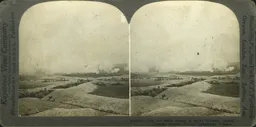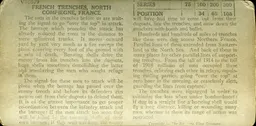Titre
Vue sur les tranchées au nord de Compiègne.
Datation
Première Guerre mondiale
Datation min.
1919
Datation max.
1920
Commentaire datation
Cette image a sans doute été réalisée après le conflit entre 1919 et 1920. Voir http://greatwarin3d.org/UU.htm
Auteur du cliché
Photographe de la maison Underwood
Fonction
Photographe et éditeur
Mention d’édition
Keystone View Company Manufacturers and Publishers
Editeur
,
Numéro dans la série
V18879
Laboratoire photographique
Compiègne
Légende sur document
V18879 - On all sides round a great furnace flamed - German attack, North Compiegne, France.
Commentaire légende
Légende imprimée en bas à droite sur le recto de la carte. Encre de couleur noire
Lieu
Architecture
Personne photographiée
Milieu - Environnement
Objet manufacturé
Texte au recto
CLEM - Archéovision
Verso inscrit
oui
Texte au verso
V18879 FRENCH TRENCHES, NORTH COMPIEGNE, FRANCE The men in the trenches before us are waiting the signal to go "over the top" in attack. The barrage which precedes the attack has already reduced the trees in the distance to mere splintered trunks. It moves onward yard by yard very much as a fire sweeps the plain, covering every foot of the ground with a rain of death. Bursting shells drive the enemy from his trenches into the dugouts, huge shells sometimes demolishing the latter and smothering the men who sought refuge in them. The signal for these men to attack will be given when the barrage has passed over the enemy trench and before its defenders can swarm out from their dugouts to defend them. It is of the utmost importance to get proper co-ordination between the infantry attack and the barrage : if the men attack too soon they will be killed by the bursting shells of their own barrage ; if they wait too long, the enemy will have had time to come out from their dugouts, line the trenches, and mow down the attackers with bomb and bullet. Hundreds and hundreds of miles of trenches like these were dug acorss Northern France. Parallel lines of them extended from Switzerland to the North Sea. And back of them in many places lay other parallel lines of supporting trenches. From the fall of 1914 to the fall of 1918 millions of men occupied these trenches, relieving each other in relays, repulsing raiding parties, going "over the top" at zero hour in the morning, or ceaselessly alert, guarding the lines from capture. The trenches were zigzagged in order to monimize the loss when under bombardment : if dug in a straight line a bursting shell would fly a long distance, killing or wounding many men, whereas in these its range of action was restricted. Copyright by The Keystone View Company
Analyse du document
Cette image provient de la série émise initialement par Underwood & Underwood rachetée en 1921 par la compagnie Keystone. Elle portait le N°14372 de la première série.
Bibliographie
http://greatwarin3d.org/UUTList4.htm
Etat de conservation
bon
Dimensions
9 x 18 cm
Info développement
Positif
Info couleur
Noir et Blanc
Propriétaire
M. Vergnieux
Lieu de conservation
Pessac
Auteur de la numérisation
Bérénice Vergnieux
Type de stéréoscopie sauvegardée
Anaglyphe (bleu / rouge)
Créateur du dépôt
Archéovision
Date de dépôt
juin 2012
Lot
LOT17 VERGNIEUX
Livraison
LIVRAISON03
Métadonnées stereo
Nom usuel
RVX192
Auteur
Photographe de la maison Underwood
Titre
Vue sur les tranchées au nord de Compiègne.
Date de création
Première Guerre mondiale
Légende
V18879 - On all sides round a great furnace flamed - German attack, North Compiegne, France.
Ville
Compiègne
Région
Nord-Pas-de-Calais-Picardie
Pays
France
Fournisseur
CLEM - Archéovision
Auteur de la description
Catherine Carponsin-Martin
Métadonnées iptc (stereo)
Nom de l'objet: RVX192
Date d'entrée de l'objet dans ArcheoGRID : 2024-12-05
Collection : LIVRAISON03


